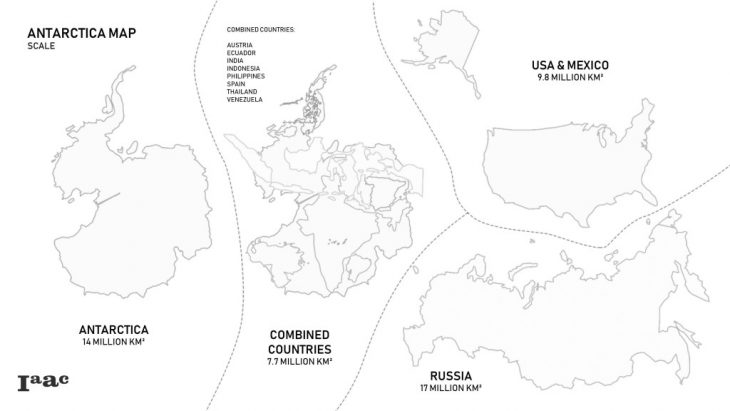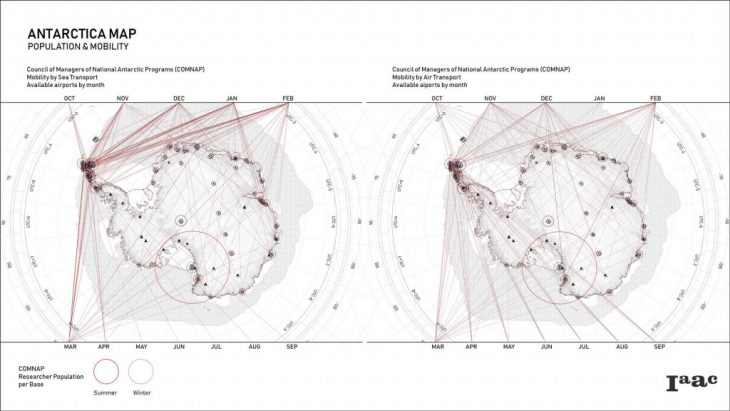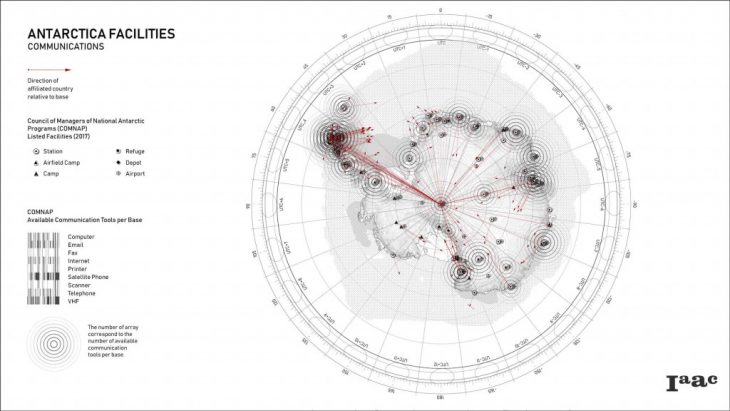Although it is the most isolated place on earth, Antarctic is one of the most productive in terms of creating knowledge. Antarctica presents a unique international ensemble of knowledge creators, that is not built on capitalism but on genuine pursuit of scientific knowledge. But how did we get here? The group explores the history of how the world perceived Antarctica as the next territorial endeavor to an international collaboration for scientific exploration.
Introduction
The True Scale of Antarctica
The most common representation of the Earth as a flat map is the Mercator projection map. However, this projection presents Antarctica as an arbitrary mass of land.
In its true scale, Antarctica is about 4 million km² larger than the United States, can fit several countries in its footprint. And so, the sheer size of Antarctica inspired the curiosity of early explorers.

History of Exploration
This map shows some of the most important expeditions that lead to the discovery of the continent and its most important features.

In 1819, Fabien Gottlieb von Bellingshausen circumnavigated Antarctica and was the first person to see the Antarctic continent. He is the second person to circumnavigate Antarctica since Captain James Cook in 1773. His explorations led to the discovery of the continent and were able to map and document the landscape, and its flora and fauna.
In 1911, Roald Amundsen led an expedition to the South Pole. His team is the first to the south pole.
In 1912, five weeks after Amundsen, Robert F. Scott and his team were able to reach the South Pole 1912. Unfortunately, he and his team perished going back before reaching the Ross Island
In 1935, Lincoln Ellsworth made the First Trans-Antarctic flight. With this, he was able to discover the Ellsworth Mountains of Antarctica.
Subsequently, these explorations early explorations sparked more interest in the south, its resources, and the potential to expand nations’ geopolitical agendas.
Geopolitical Agendas
The sheer size, potential, and resources that the continent offers led to several nations claiming territory in Antarctica.

However, the Antarctic Treaty was ratified. Consequently, freezing all claims to the territory.
“the Treaty freezes territorial claims. In other words, it does not ask the 7 possessed countries to renounce their claims, but it requires them not to mention them. Similarly, it prevents any further claims (Article IV).”
The treaty also states that it is:
“RECOGNIZING that it is in the interest of all mankind that Antarctica shall continue for ever to be used exclusively for peaceful purposes and shall not become the scene or object of international discord;
ACKNOWLEDGING the substantial contributions to scientific knowledge resulting from international cooperation in scientific investigation in Antarctica;”
Knowledge Creation
The Antarctic Peninsula
The map below shows the location of base camps, the country that manages them, ice cover, and relative time zones of the region.
The Antarctic Peninsula is a major transportation and communication gateway of the continent.
According to the COMNAP data, there are about 30 nations that manage 108 base camps. Meanwhile, a significant number of these base camps are located at the western tip of the continent or the Antarctic Peninsula. There are several reasons why this is the case.
Firstly, this is where the closest land mass to Antarctica is. Argentina and Chile shares this area that provides a take off point to Antarctica. It is about 1238 km south of Ushuaia, the southern most city of Argentina.

Secondly, with minimal ice cover, this area is able to provide sea transport access year round. The data shows that most of sea transportation are within this area and during winter, the time in which air transport is not safe.

Lastly, due to the proximity to Argentina and Chile, the peninsula is able to establish a more reliable and diverse communication network.

The Knowledge Economy
The Internet of Cities studio tasked the research group to explore drivers that impact today’s urban environment and discuss what parameters affect this driver.
The Knowledge Economy is an economic structure that is based on the intellectual capacity of a city to produce information or knowledge. In the age of inter-connectivity, data and information can be extracted and analysed instantaneously. As a result, it leads to rapid production of new knowledge and innovation. Cities that are able to produce and manage creative and innovative environments are leading the world in churning out new information and technology.
Tokyo is one example. Of the top 20 most innovative cities in the world, Tokyo holds the no.1 spot and is the largest of the group in terms of population. Its innovative success is derived from the local connections between producers. Tokyo clusters local companies by creating a network of different roles in the production process, while maintaining external trade networks that provide the distribution of products among these clusters. The domestic economy serves as test markets for new technology. It serves as a battle ground for these innovations before introducing them to the international market.
Another example is Shenzhen. From a little fishing village to an economic powerhouse for China, Shenzhen is a product of policy driven reforms. It profited from special regulations and its establishment as a special economic zone which served as a magnet for investors to flock the city.
Cross Reference
Where is knowledge in Antarctica?
Antarctica, since its discovery, has been a pursuit for knowledge. Today, it is a home to a diverse collection of research and research facilities.
Antarctica has average population of 4000 people which consists of scientists and other well educated professionals. Thus, it has an abundance of intellectual capital. However, the concentration of base camps in one area of Antarctica presents a challenge on how to foster collaboration and network in the vast continent of Antarctica. The sheer size of the continent hinders the creation of physical ICT infrastructure, and transportation networks. In order to create a more robust and collaborative network of knowledge creation platforms, the group will have to map out the following information: the type of information produced, where does this information come from, where does it go, and how is it being collected. But most importantly, How can the model of Knowledge Economy be part of creating this culture of innovation?
Sources:
Basecamps Dataset: COMNAP
Tourism Data: IAATO
Territorial Claims Data: Claims Data
Country Size Comparison: True Size Of…
Australian Antarctic Division, 2019
Dr. Andrew J. Marsh, 2014
The Antarctic Treaty: Antarctic Treaty
Snow and Ice Data: NSIDC
Image of Mercator Map from: Wikimedia
Tokyo Research: Innovative Tokyo
Shenzhen Research: Metropolitan Shenzhen
The Knowledge of Antarctica is a project of IaaC, Institute for Advanced Architecture of Catalonia
developed at Master in City & Technology in (2019/2020) by:
Students: Jianne Libunao, Rovianne Santiago, Christian Lyle La Madrid
Faculties: Mathilde Marengo, Edouard Cabay
